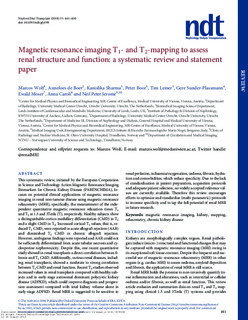| dc.contributor.author | Wolf, Marcos | |
| dc.contributor.author | de Boer, Anneloes | |
| dc.contributor.author | Sharma, Kanishka | |
| dc.contributor.author | Boor, Peter | |
| dc.contributor.author | Leiner, Tim | |
| dc.contributor.author | Sunder-Plassman, Gere | |
| dc.contributor.author | Moser, Ewald | |
| dc.contributor.author | Caroli, Anna | |
| dc.contributor.author | Jerome, Neil Peter | |
| dc.date.accessioned | 2019-04-10T06:06:22Z | |
| dc.date.available | 2019-04-10T06:06:22Z | |
| dc.date.created | 2018-12-17T13:49:04Z | |
| dc.date.issued | 2018 | |
| dc.identifier.citation | Nephrology, Dialysis and Transplantation. 2018, 33 ii41-ii50. | nb_NO |
| dc.identifier.issn | 0931-0509 | |
| dc.identifier.uri | http://hdl.handle.net/11250/2593916 | |
| dc.description.abstract | This systematic review, initiated by the European Cooperation in Science and Technology Action Magnetic Resonance Imaging Biomarkers for Chronic Kidney Disease (PARENCHIMA), focuses on potential clinical applications of magnetic resonance imaging in renal non-tumour disease using magnetic resonance relaxometry (MRR), specifically, the measurement of the independent quantitative magnetic resonance relaxation times T1 and T2 at 1.5 and 3Tesla (T), respectively. Healthy subjects show a distinguishable cortico-medullary differentiation (CMD) in T1 and a slight CMD in T2. Increased cortical T1 values, that is, reduced T1 CMD, were reported in acute allograft rejection (AAR) and diminished T1 CMD in chronic allograft rejection. However, ambiguous findings were reported and AAR could not be sufficiently differentiated from acute tubular necrosis and cyclosporine nephrotoxicity. Despite this, one recent quantitative study showed in renal transplants a direct correlation between fibrosis and T1 CMD. Additionally, various renal diseases, including renal transplants, showed a moderate to strong correlation between T1 CMD and renal function. Recent T2 studies observed increased values in renal transplants compared with healthy subjects and in early-stage autosomal dominant polycystic kidney disease (ADPKD), which could improve diagnosis and progression assessment compared with total kidney volume alone in early-stage ADPKD. Renal MRR is suggested to be sensitive to renal perfusion, ischaemia/oxygenation, oedema, fibrosis, hydration and comorbidities, which reduce specificity. Due to the lack of standardization in patient preparation, acquisition protocols and adequate patient selection, no widely accepted reference values are currently available. Therefore this review encourages efforts to optimize and standardize (multi-parametric) protocols to increase specificity and to tap the full potential of renal MRR in future research. | nb_NO |
| dc.language.iso | eng | nb_NO |
| dc.publisher | Oxford Academic | nb_NO |
| dc.rights | Navngivelse-Ikkekommersiell 4.0 Internasjonal | * |
| dc.rights.uri | http://creativecommons.org/licenses/by-nc/4.0/deed.no | * |
| dc.title | Magnetic resonance imaging T1- and T2-mapping to assess renal structure and function: a systematic review and statement paper | nb_NO |
| dc.type | Journal article | nb_NO |
| dc.type | Peer reviewed | nb_NO |
| dc.description.version | publishedVersion | nb_NO |
| dc.source.pagenumber | ii41-ii50 | nb_NO |
| dc.source.volume | 33 | nb_NO |
| dc.source.journal | Nephrology, Dialysis and Transplantation | nb_NO |
| dc.identifier.doi | 10.1093/ndt/gfy198 | |
| dc.identifier.cristin | 1644215 | |
| dc.description.localcode | Copyright © 2018, Oxford University Press. Open Access. This article is available under the Creative Commons CC-BY-NC license and permits non-commercial use, distribution and reproduction in any medium, provided the original work is properly cited. | nb_NO |
| cristin.unitcode | 194,65,25,0 | |
| cristin.unitname | Institutt for sirkulasjon og bildediagnostikk | |
| cristin.ispublished | true | |
| cristin.fulltext | original | |
| cristin.qualitycode | 1 | |

